S.T.E.A.M. Essential Learning Standards
By the end of second grade students will be able to:
- ask questions, make observations, and gather information about a situation people want to change to define a simple problem that can be solved through the development of a new or improved object or tool.
- develop a simple sketch, drawing, or physical model to illustrate how the shape of an object helps it function as needed to solve a given problem.
- analyze data from tests of two objects designed to solve the same problem to compare the strengths and weaknesses of how each performs.
- define a simple design problem reflecting a need or a want that includes specified criteria for success and constraints on materials, time, or cost.
- generate and compare multiple possible solutions to a problem based on how well each is likely to meet the criteria and constraints of the problem.
- plan and carry out fair tests in which variables are controlled and failure points are considered to identify aspects of a model or prototype that can be improved.
- define the criteria and constraints of a design problem with sufficient precision to ensure a successful solution, taking into account relevant scientific principles and potential impacts on people and the natural environment that may limit possible solutions.
- evaluate competing design solutions using a systematic process to determine how well they meet the criteria and constraints of the problem.
- analyze data from tests to determine similarities and differences among several design solutions to identify the best characteristics of each that can be combined into a new solution to better meet the criteria for success.
- develop a model to generate data for iterative testing and modification of a proposed object, tool, or process such that an optimal design can be achieved.

Science, Technology, Engineering, Art, and Math
The website Education Closet defines STEAM as “an educational approach to learning that uses Science, Technology, Engineering, the Arts and Mathematics as access points for guiding student inquiry, dialogue, and critical thinking. The end results are students who take thoughtful risks, engage in experiential learning, persist in problem-solving, embrace collaboration, and work through the creative process. These are the innovators, educators, leaders, and learners of the 21st century!"*
In the HNR School District we have various forms of STEAM instruction. At the 4K - 2nd grade levels, STEAM concepts and skills are integrated into projects in many subject areas. In grades 3 - 6 students meet once a week and are presented various problems and challenges to solve. Students work with each other to develop inquiry and problem solving skills using brains and hands. At the 7th and 8th grade levels students meet 3 times a week. They are allowed to choose an art focus or a science and engineering focus. Students continue to develop their creative problem solving skills through building, creating, and coding.